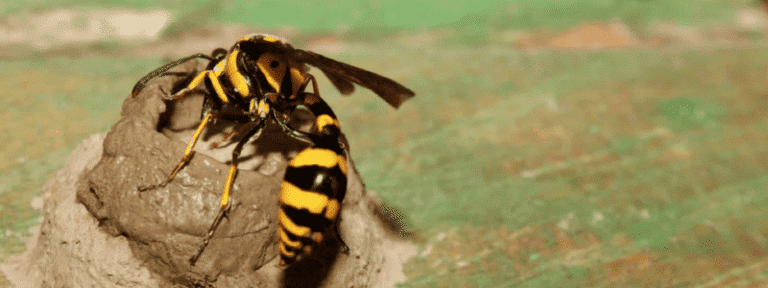Carpenter bees are intelligent bugs with a strong work ethic. They’re mostly harmless to humans, but their presence can still create serious problems.
In this blog on carpenter bees, we’ll answer the following questions:
- What are carpenter bees?
- Are carpenter bees aggressive?
- How do you get rid of carpenter bees fast?
- What will keep carpenter bees away?
- Should I get rid of carpenter bees myself?
What Are Carpenter Bees?

Carpenter bees, or wood-boring bees, look similar to bumble bees apart from their large black or metallic blue-green, hairless abdomen and fuzzy black and yellow front end. They’re large, solitary bees with a habit of excavating and nesting in wood, thus giving them the name “carpenter.” Over 500 species of carpenter bees are found in various parts of the world.
While they play an essential role in pollination, carpenter bee nesting sites can be a nuisance to humans, causing damage to wood structures in buildings. Female carpenter bees will create nest tunnels in wood that can overtime weaken it and create structural damage.
Carpenter bees, unlike other types of bees, prefer smaller nests that consist of around four females and twelve males. If a nest is left alone, a new generation of adult carpenter bees will return to the nest year after year. The number of bees living in a nest can increase over time as well as female carpenter bees lay eggs once per year, usually six to eight at a time.
Are Carpenter Bees Aggressive?
The male carpenter bees are more aggressive than the females and will hover toward people who come close to their territory. That said, male carpenter bees are not a threat to humans or animals, seeing that they don’t possess a stinger. Females do have a stinger, but they’re generally docile and won’t sting unless provoked or if they feel threatened.
How Do You Get Rid of Carpenter Bees Fast?

Undealt infestations can lead to damage to your home’s structure. The most common and effective way to get rid of carpenter bees is pesticides. Aside from pesticides, you can spray the surrounding area with deterring scents like peppermint, tea tree, and lemon essential oils.
Almond oil can repel bees when applied to wood or the outside of their nest. You can place solutions of water and oils in a spray bottle and apply them around bee holes to encourage them to leave the nest. Frequent use is the best way to utilize this method.
Carpenter bees also dislike loud noise. If you suspect or spot a nest, play music near it. The vibrations can make them evacuate their nest and not return.
What Will Keep Carpenter Bees Away?
Taking preventative measures before an infestation is the best form of protection. Identify possible spots where bees can build their nests. Holes and exposed wood around your home must be painted or sealed up. You can also varnish the wood surfaces to create a protective layer that keeps bees from drilling holes.
If carpenter bees are an ongoing problem, scheduling regular maintenance can eliminate existing nests and prevent future ones from forming.
Should I Get Rid of Carpenter Bees Myself?

While carpenter bees aren’t very dangerous to humans, females still have stingers and can attack when provoked. Getting rid of a nest on your own puts you at risk of being stung, among other things. Depending on where the nest is, you may have to reach difficult places, making it more difficult not to disturb the bees in the process.
Some DIY methods can help with carpenter bees, such as citrus sprays. Citrus sprays can repel bees and make your property unappealing. You can DIY citrus spray by slicing fruit and boiling it to release the juice, about 10-15 minutes. Once cooled, place it inside a spray bottle and spray around the outside area of the nest.
If smaller measures aren’t working or you’re dealing with a large infestation, your best bet is to call a professional. Professional pest control has the proper tools, protection, and knowledge to apply to an infestation to minimize risks and increase efficiency.






